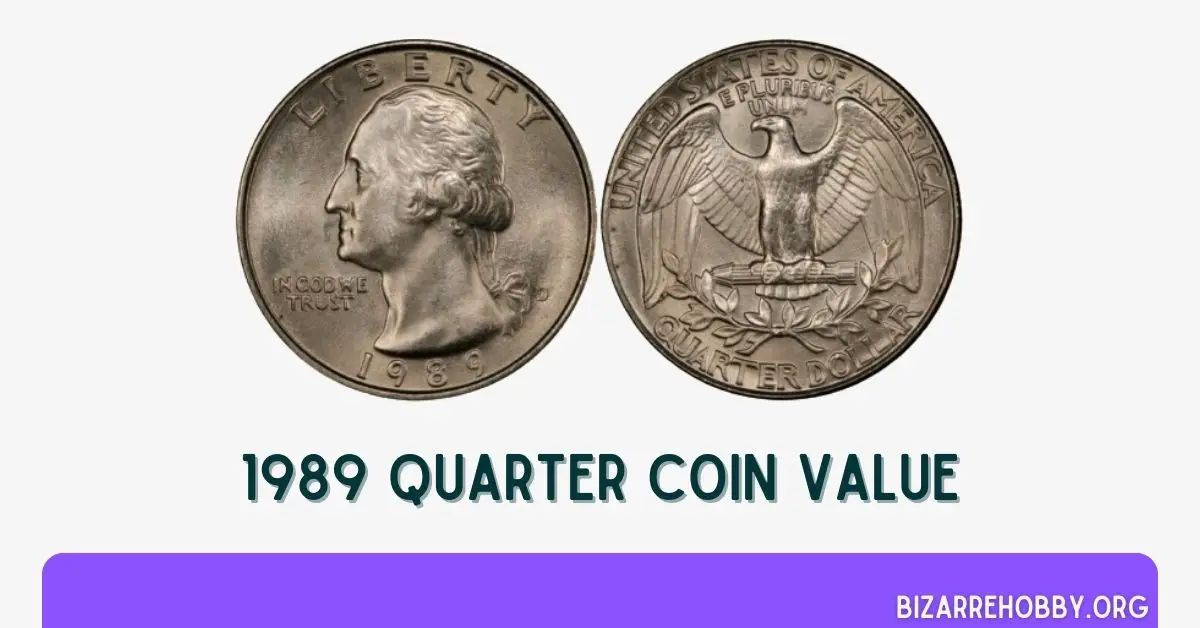The Washington quarter, a coin with a fascinating legacy, has been in circulation for over nine decades. Initially conceived as a limited-edition commemorative item in 1932, it unexpectedly became a permanent fixture in American currency. The coin’s obverse features George Washington’s profile, honoring the nation’s first President.
A significant change occurred in 1965 when the U.S. Mint altered the quarter’s composition. The original silver content was replaced with a more cost-effective blend of nickel and copper. This shift in materials marked a turning point in the coin’s history and value.
Collectors generally show less interest in the post-1965 quarters compared to their silver predecessors. This preference impacts the market value of coins from later years, such as those minted in 1989. The diminished collector appeal for modern quarters is primarily due to their more common composition and widespread availability.
It’s worth noting that while newer quarters may not hold the same allure for numismatists, they continue to play a vital role in everyday transactions and remain an integral part of American currency.
1989 Quarter Value Chart
| Condition | 1989 P quarter | 1989 D quarter | 1989 S quarter |
|---|---|---|---|
| MS 65 | $10 | $20 | – |
| PR 65 | – | – | $5 |
History Of The 1989 Washington Quarter

The quarter coin, a cornerstone of American currency, has undergone several transformations since its inception in 1796. Initially, the coin showcased Lady Liberty on the obverse and an eagle on the reverse, a design that persisted for over a century.
In 1916, after 134 years, the quarter received a makeover. The new “Standing Liberty” design maintained thematic continuity, still featuring Lady Liberty on the front and the American bald eagle on the back.
The year 1932 marked a significant shift with the introduction of the Washington quarter. This coin was originally intended as a one-year commemorative issue to celebrate the bicentennial of George Washington’s birth. The process leading to this new design began in 1924 when Congress established a commission to oversee the jubilee celebrations.
Initially, the plan was to create a commemorative half-dollar. The commission organized a design competition, stipulating that the obverse should be based on Jean-Antoine Houdon’s bust of Washington, while leaving the reverse design open to artistic interpretation. Sculptor Laura Gardin Fraser’s design was selected as the winner.
Plans changed when Congress decided to redesign the quarter instead of the half-dollar for the commemoration. In a renewed competition, Fraser’s design again emerged victorious. However, in a controversial move, Treasury Secretary Andrew Mellon overruled the commission’s choice, selecting John Flanagan’s design instead. This decision stood firm even after a change in leadership at the Treasury.
The original Washington quarters were 90% silver. However, rising silver prices in 1965 forced the U.S. Mint to alter the coin’s composition to reduce production costs. Despite this change in metal content, the visual design remained constant until 1998.
This history highlights how economic factors, artistic competitions, and political decisions have all played roles in shaping one of America’s most familiar coins. The Washington quarter, born from a commemorative project, has become a lasting tribute to the nation’s first president and an enduring piece of American numismatic history.
1989 Washington Quarter Coin Types
| Location | Year | Minted |
|---|---|---|
| Denver | 1989 D quarter | 896,535,597 |
| Philadelphia | 1989 P quarter | 512,868,000 |
| San Francisco | 1989 S quarter (proof) | 3,220,194 |
| Total | – | 1,412,623,791 |
Features Of The 1989 Washington Quarter
Features Of The 1989 Washington Quarter
The Washington Quarter of 1989 represents a fascinating chapter in American numismatics, embodying both tradition and adaptation. This coin maintained its iconic design for over six decades, from 1932 to 1998, showcasing the U.S. Mint’s commitment to consistency in certain aspects of currency design.
Obverse Design of 1989 Washington Quarter
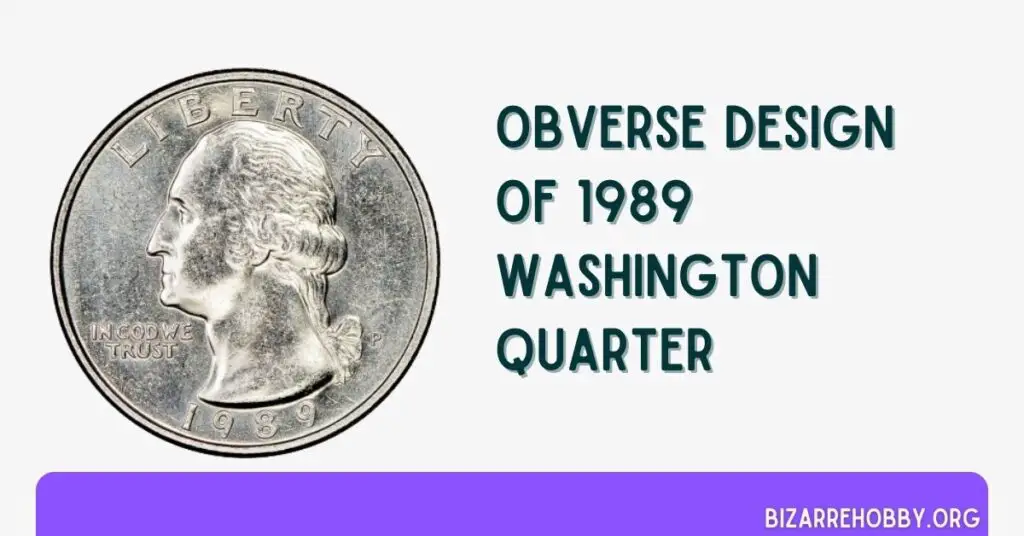
The front of the 1989 quarter features a left-facing profile of George Washington, based on Jean-Antoine Houdon’s 1785 sculpture. This portrayal captures the first President’s dignified essence. The word “LIBERTY” appears along the upper rim, while the minting year is inscribed at the bottom. The motto “IN GOD WE TRUST” is positioned in front of Washington’s portrait. The mint mark (P, D, or S) is located on the right, indicating the coin’s origin.
Reverse Design of 1989 Quarter
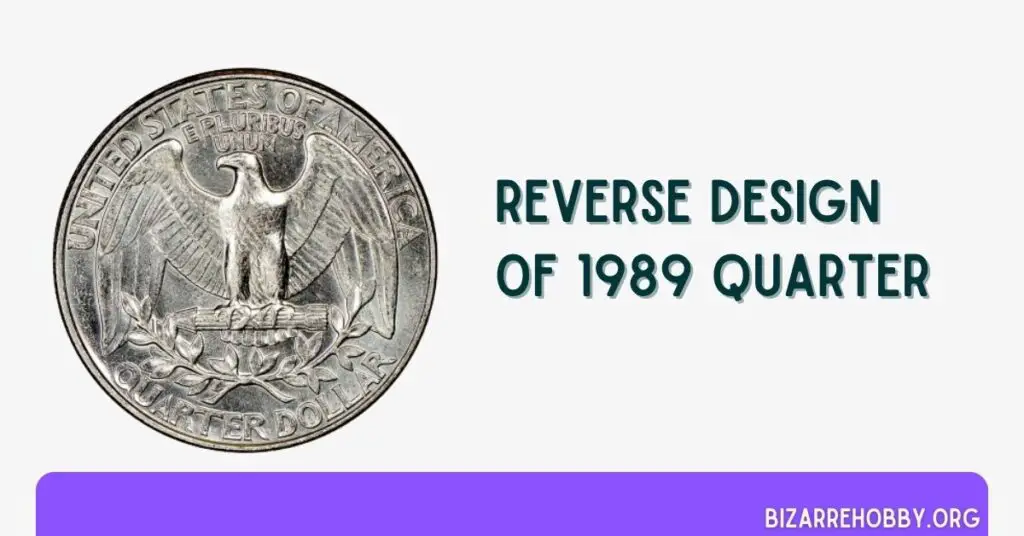
The back of the coin prominently displays the American bald eagle, a powerful national symbol. The eagle faces left with outstretched wings, clutching a bundle of arrows in its talons – symbolizing America’s readiness for defense. Below, two crossed olive branches represent peace, creating a balance with the arrows. The Latin phrase “E PLURIBUS UNUM” appears above the eagle, while “UNITED STATES OF AMERICA” arches along the top edge. “QUARTER DOLLAR” is inscribed along the bottom rim.
Composition and Physical Characteristics of 1968 Washington Quarter
In 1965, due to rising silver prices, the U.S. Mint changed the quarter’s composition. The 1989 quarter is made of a copper-nickel alloy (75% copper, 25% nickel). It weighs 5.67 grams (0.2 ounces), measures 24.3 mm (0.95669 inches) in diameter, and is 1.75 mm (0.06889 inches) thick. The coin features a reeded edge, consistent with other quarters of its era.
This detailed examination of the 1989 Washington Quarter reveals how it maintains historical design elements while adapting to economic realities through its composition. It serves as a tangible link to America’s past, blending artistry, symbolism, and practicality in a single, widely-circulated coin.
1989 Washington Quarter Coin Details
| Face value | 25 cents ($0.25) |
| Coin weight | 0.20 ounces (5.67 g) |
| Compound | Copper (75%) and nickel (25%) with a clad core |
| Coin thickness | 0.06889 inches (1.75 mm) |
| Coin diameter | 0.9551 inches (24.26 mm) |
| Shape | Round |
| Edge | Reeded |
How to Grade 1989 Washington Quarter?
Unlike most everyday coins, a 1989 quarter’s value can skyrocket depending on its condition. Think of it like a rare baseball card – a well-preserved 1989 quarter might be worth significantly more than its face value to a collector.
For the most accurate idea of your coin’s worth, consider consulting a professional coin grader. These experts meticulously examine a coin’s surface, luster (shine), and any imperfections to assign a grade based on a standardized system. This grading system, established by numismatists (coin collectors) in the 1970s, uses the Sheldon scale to ensure consistent evaluation across different appraisers. Thanks to this system, you can easily compare your coin’s grade to price guides and get a reliable estimate of its value.
| Grade Number | Grade |
|---|---|
| 1 | Basal State-1 |
| 2 | Fair |
| 3 | Very Fair |
| 4, 5, 6 | Good |
| 7, 8, 10 | Very Good |
| 12, 15 | Fine |
| 20, 30 | Very Fine |
| 40 | Extremely Fine |
| 50 | About Uncirculated |
| 60 | Mint State |
| 65 | Mint State |
| 70 | Mint State |
Please check BizarreHobby’s Washington Quarter grading guide to know your coin scale, It’s the necessary step to know the exact value of your coin.
1989 Washington Quarter Value Guides
The year 1989 was indeed a remarkable one for the production of Washington quarters in the United States. A staggering 1,412,623,791 Washington quarters were minted in 1989, showcasing the U.S. Mint’s impressive production capacity.
Three different U.S. Mint facilities contributed to this substantial output:
- Philadelphia Mint (P)
- Denver Mint (D)
- San Francisco Mint (S) – for proof coins only
The mint mark on each coin is crucial for identification. It indicates which facility produced the coin:
- “P” for Philadelphia
- “D” for Denver
- “S” for San Francisco (proof coins)
This information is valuable for collectors and numismatists, as the mint of origin can influence a coin’s value and rarity. This high production volume reflects the robust economic activity and coin demand in the late 1980s. It also demonstrates the U.S. Mint’s ability to meet large-scale circulation needs across the country.
While the high mintage generally means these coins are common, it also presents opportunities for collectors:
- Variety seeking: With such a large production, there’s potential for interesting varieties or errors.
- Condition rarity: Finding high-grade specimens, especially from circulation, can be challenging and rewarding.
Understanding the mintage figures and mint marks helps collectors and enthusiasts appreciate the scale of coin production and aids in accurately identifying and valuing these 1989 Washington quarters.
1989 P Quarter Value

The 1989 Philadelphia Mint Washington Quarter presents an interesting case study in modern coin collecting. Here’s a detailed breakdown of its production and value:
Mintage and Identification
- Total production: 512,868,000 coins
- Second highest mintage for Washington Quarters in 1989.
- Identifiable by the “P” mint mark on the obverse.
Value Based on Condition
- Circulated Specimens:
- Generally worth only face value ($0.25) due to heavy circulation
- Uncirculated (Mint State) Coins:
- MS 60 to MS 65: $1 to $10
- MS 66: $35 to $175
- MS 67: $465 to $1,500
The value progression clearly demonstrates the premium placed on higher-grade specimens, particularly those in MS 67 condition.
The highest known sale for this coin occurred in 2007, where an MS 67 graded specimen sold for $1,955 at auction. This sale highlights the potential value of exceptionally preserved examples, even for relatively recent and high-mintage coins.
Key Observations
- Condition is paramount: The dramatic price increase from MS 66 to MS 67 (potentially 10x or more) underscores the importance of pristine preservation.
- Rarity in high grades: Despite the high mintage, finding these coins in top condition is challenging, hence the significant premium for MS 67 specimens.
- Collector interest: The high auction price indicates strong collector demand for perfect or near-perfect examples of modern coins.
- Investment potential: While most 1989-P quarters are worth face value, the potential for high-grade specimens to command significant premiums offers an interesting angle for collectors and investors.
This information about the 1989-P Washington Quarter illustrates how factors like mintage, circulation, preservation, and collector interest interact to determine a coin’s value in the numismatic market. It also demonstrates that even common, modern coins can have substantial value if they’re in exceptional condition.
1989 D Quarter Value

The 1989 Denver Mint Washington Quarter holds a significant place in U.S. coinage history due to its exceptionally high mintage. Here’s a breakdown of its production and value:
Mintage and Identification
- Total production: 896,535,597 coins
- This was by far the highest output of any mint for Washington Quarters in 1989.
- Identifiable by the “D” mint mark on the obverse (front) of the coin.
Value Based on Condition
- Circulated Specimens:
- Worth face value ($0.25) or up to $1 in circulation
- Uncirculated (Mint State) Coins:
- MS 60 to MS 65: $1 to $20
- MS 66: $25 to $46
- MS 67: $375 to $625 on average
The large mintage significantly impacts the coin’s value, making even uncirculated specimens relatively affordable for collectors. However, the value increases substantially for coins in pristine condition, particularly those graded MS 67 or higher.
The highest known sale for this coin occurred on eBay in 2020, where an MS 67 graded specimen sold for $764. This sale demonstrates that even with high-mintage modern coins, exceptional examples can command premium prices.
For collectors and investors, this information highlights several key points:
- Condition is crucial in determining a coin’s value, especially for common dates.
- Even recent, high-mintage coins can have significant value if they’re in top condition.
- The market for high-grade modern coins can be quite active, as evidenced by the eBay sale.
This 1989-D Washington Quarter serves as an excellent example of how mintage, preservation, and market demand interact to determine a coin’s value in the numismatic world.
1989 S Quarter (Proof) Value
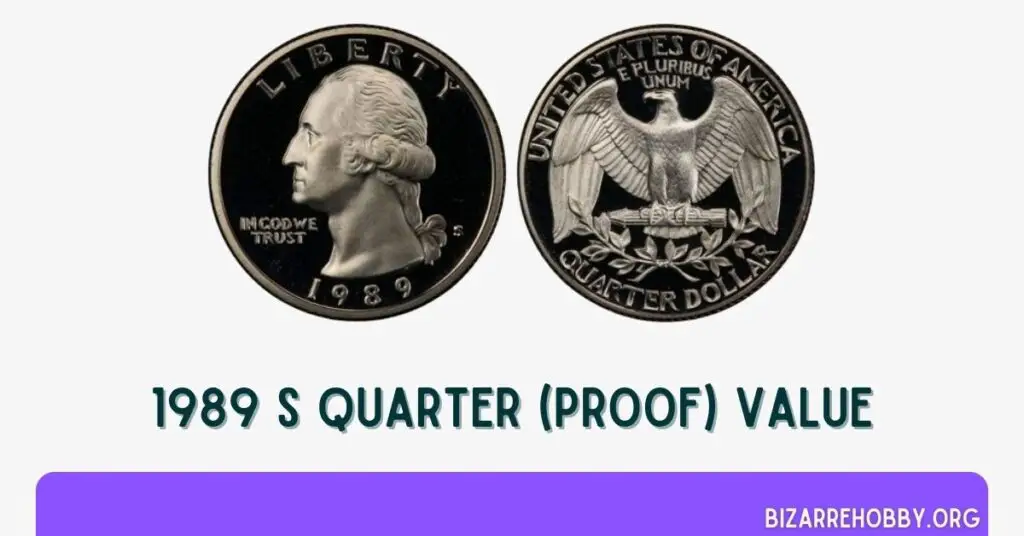
The 1989 Proof Washington Quarters, identifiable by their “S” mint mark, were exclusively produced at the San Francisco Mint. These coins, with a total mintage of 3,220,194, were specifically created for collectors and were not intended for circulation.
The production process for these proof coins was notably different from standard strikes:
- Higher quality planchets were used as the base material.
- The design was struck twice to enhance detail and sharpness.
- Mint workers manually polished each coin as a final step.
These meticulous production methods resulted in coins with exceptional clarity and detail. Some proof coins exhibit a cameo or deep cameo (DCAM) contrast, where frosted design elements stand out against mirror-like fields. This contrast can significantly influence a coin’s value.
Current average prices for 1989 Proof Washington Quarters in DCAM quality:
- PR 67 DCAM: Approximately $6
- PR 68 DCAM: Approximately $10
- PR 69 DCAM: Approximately $16
- PR 70 DCAM: Approximately $34
It’s worth noting that these coins are relatively easy to find in well-preserved condition today, which impacts their overall value.
The highest recorded sale for a 1989 Proof Quarter was a PR 70 DCAM specimen, which sold for $253 at an auction in 2004. This premium price demonstrates the value that collectors place on perfect-condition proof coins, especially those with deep cameo contrast.
For collectors and enthusiasts, these proof quarters offer an opportunity to own a high-quality example of U.S. coinage, showcasing the mint’s finest craftsmanship. While not exceedingly rare, top-grade specimens with deep cameo contrast can still command respectable prices in the numismatic market.
Rare 1989 Washington Quarter Errors List
The 1989 Washington Quarter, like many coin series, has its share of rare errors that intrigue collectors. These imperfections, while undesirable for mints, often become prized possessions for numismatists.
It’s worth noting that while these errors make the coins more valuable than standard issues, the 1989 Washington Quarter errors are not among the most sought-after in the numismatic world. Their relative abundance in circulation means that their value, while higher than face value, is not extraordinarily high.
For collectors, these errors offer an interesting subset of the Washington Quarter series to pursue. They provide a glimpse into the minting process and its occasional imperfections, adding an element of intrigue to coin collecting beyond mere date and mint mark variations.
Here’s an overview of some notable errors found in the 1989 Washington Quarter series:
Off-Center
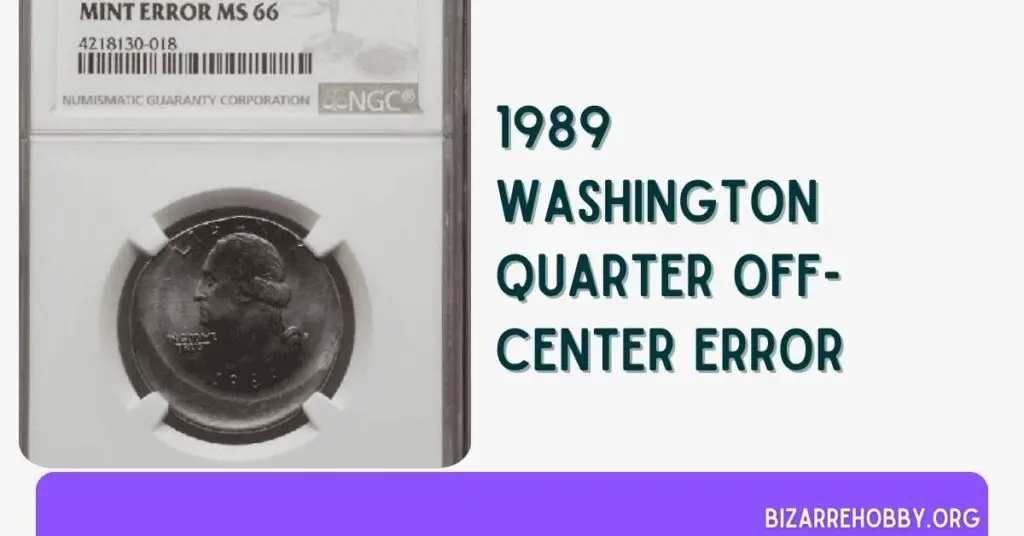
This common minting error occurs when the die strikes a misaligned planchet. The result is a coin with part of its design missing. The value of these error coins depends on the percentage of the design that’s off-center, with prices ranging from $10 to over $100. However, the date and mint mark must be visible for the coin to hold significant value.
Broad Struck
This error happens when the collar that gives the coin its standard shape and thickness malfunctions. The result is a thinner, wider coin that maintains its standard weight. These 1989 quarters can fetch between $4 and $80, depending on the error’s severity.
Doubled Die
This error creates a doubling effect on letters and design elements. The value of these coins varies based on the visibility of the doubling, with prices typically ranging from $3.50 to $20 on the collector’s market.
Re-Punched Mint Mark
This error occurs when the mint mark is struck multiple times, with the strikes not aligning perfectly. These 1989 quarters usually sell for $2 to $20, depending on the error’s prominence.
Where To Sell Your 1989 Washington Quarter ?
There are several options for selling your 1989 Washington Quarter! Online marketplaces like eBay or coin-specific forums are popular choices. If you’re looking for a local option, coin shops are a great resource. Remember, I have a whole post on the nitty-gritty of selling coins online – check it out for tips on maximizing your return!
FAQs on 1989 Washington Quarter
What Makes A 1989 Washington 25-Cent Coin Rare?
1989 Washington quarters are common, but high-grade, well-preserved ones can be both rare and valuable.
Which 1989 Washington 25-Cent Coins Are Worth A Lot Of Money?
Most common 1989 Washington quarters are worth face value. However, certain condition and mintmark combinations can be valuable. For instance, a 1989 S PR 70 with DCAM quality sold for $253 in 2004.
How Much Are The 1989 Washington 25-Cent Coins From Philadelphia Worth?
The value of 1989 Washington 25-cent coins from Philadelphia depends on their condition. In circulated condition, they are worth face value ($0.25), while uncirculated (mint state) coins can be much more valuable.
What Are The Most Expensive Washington Coins In Coinage History?
The value of Washington quarters depends on their type (silver or clad) and condition (grade). Here are some of the top sellers:
Type 1 (Silver): 1932-D MS66 ($143,750), 1932-S MS66 ($45,500), 1949-D MS68 ($43,475)
Type 2 (Clad): 1966 MS68+ ($21,000), 1983-P MS65 ($15,862.50), 1970-D MS69 ($15,000)
